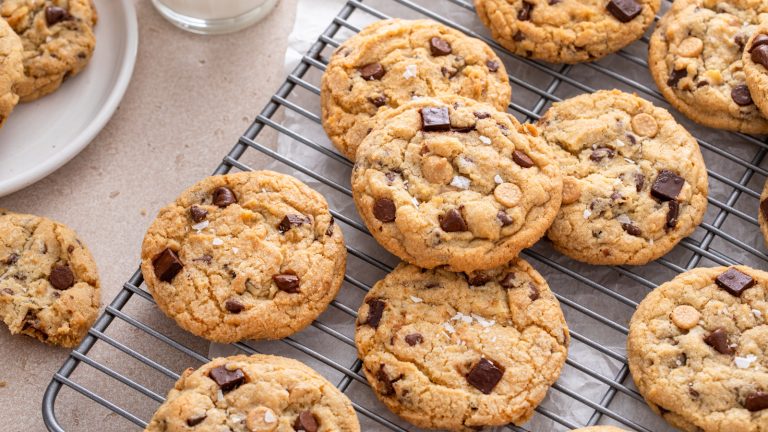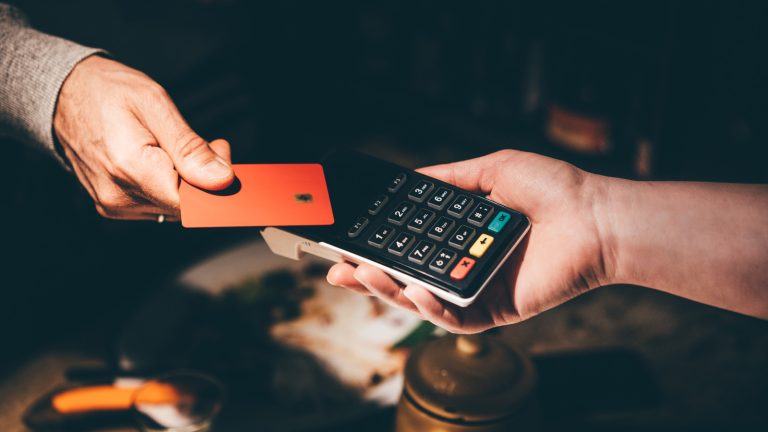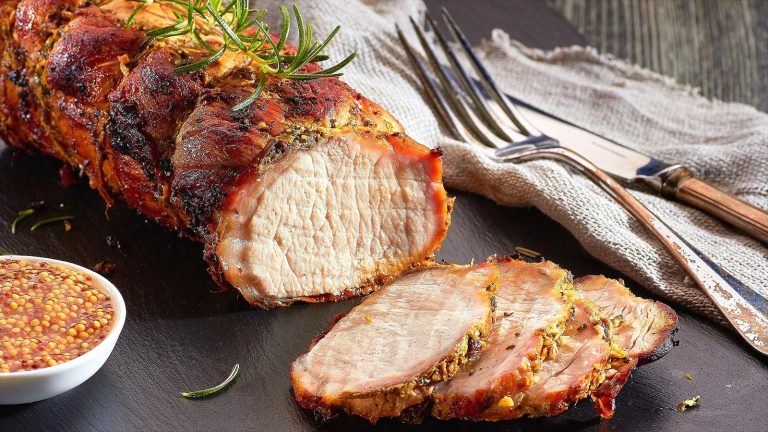Chrome is super far out, man, and there’s nothing quite as groovy as some yellow and pink patterned wallpaper! The 1960s were a time of new gadgets and styles that made cooking easier and turned kitchens into bold statements of decor and design.
If you love a retro kitchen, one of the trends below will have your space looking amazing and ready to host the gang. From bold colors to futuristic designs (at least, what chefs in the ’60s thought the future would look like), these elements scream vintage cool. Add in some of the best candies from the decade and you’ll be feeling nostalgic in no time.
We’d love to see a resurgence of these old-school decorating styles. Fortunately, you can update your own space with some retro favorites, unique materials, or recreations that will make you feel as though you’ve stepped through a time warp. Try one of these trends on a small scale to test the waters or go all-in with a full kitchen reno.
Bold fabric patterns
Colorful and bold patterns were everywhere in the 1960s. You could often find them in the kitchen, on wallpaper or on chairs. This decade was all about coordinating, so the same colors that appeared in upholstery also caught the eye in a hanging dish towel or window valances. The 1960s were characterized by groovy flower patterns, as well as geometric shapes and repeated patterns featuring bright colors.
Some vintage fabrics incorporate futuristic motifs to highlight the advances in technology that came with the 1960s. The space race was in full swing, and everyone from NASA to homemakers was obsessed with all things space travel. Fabric with vaguely technical patterns, such as dots and bold lines, was also popular in the kitchen.
Find your favorite kitchen pieces with eye-catching patterns to bring this ’60s trend to your space or create something custom. When browsing fabrics, you may be able to search by decade to make things easier. But if you can’t, look for wavy flowers, large prints, and a mix of colors.
Wallpaper in the kitchen
Today, paint is generally preferred for kitchen walls. It’s easy to apply, doesn’t cost a lot, and comes in an almost endless variety of colors to suit every style. Best of all, the right paint is wipeable, a must-have feature in the kitchen. Some areas prone to spills and splatters get a special backsplash of tile. But in the 1960s, wallpaper was often used to introduce colors and patterns.
Vintage wallpaper from the 1960s can be hard to come by and quite expensive, since true vintage options aren’t always available in large amounts. If you’re set on using an authentic wall covering from the ’60s, consider an accent wall. It can achieve the same style for a fraction of the cost, plus it is a great way to highlight special architectural features. If you find a wallpaper that you love but it isn’t enough to cover a large area, cut it into large panels and frame them. Hang them on the wall to put a modern twist on the ’60s look. You can also find similar designs in reproduction wallpapers, often in larger quantities and at more affordable prices.
Angular furniture
Kitchen furniture leaned heavily into angular, futuristic designs. From triangular-shaped table tops to round tables with sleek bases, the furniture that allowed people to sit and enjoy their food during this decade was all about making a statement. Bright colors were also available in Formica, which was both durable and affordable. Formica began as a material used in electrical insulation in 1913, but by the 1960s, this laminate material had become one of the most common choices for kitchen countertops and tables. It was easy to wipe and clean, plus there were plenty of design options that people liked during the decade. Tables and chairs often had tapered legs to accentuate the shape.
Mid-century modern is definitely an on-trend look, and we remain big fans. Laminate tables and counters are still used, although they tend to be more subdued with finishes that replicate other natural materials, such as wood and stone. However, we must give credit to the designers of the 1960s who knew how to transform a simple table into a bold, colorful statement. Updating your furniture is a fantastic way to add a touch of vintage style to your kitchen without undertaking a full renovation.
Matching appliances
Homeowners in the 1960s loved the newest and best appliances, which were often marketed as a way to make cooking and cleaning easier. When they came in matching sets, the look was even more iconic. We’re not talking stainless steel, black, or white. Coordinating appliances in the 1960s had colors like orange, yellow, or green. Pastel pink and teal were particularly popular during this time period. Avocado and harvest gold became the go-to choices toward the end of the ’60s and into the ’70s, but if you want to follow in the spirit of a vintage trendsetter, you could put these hues in your own kitchen. Red and white were also popular because they followed the on-trend decor of the classic 1950s and 1960s diners.
It’s essential to note that while patterns were all the rage when it came to fabrics and wallpaper, appliances tended to be one tone and matched. Getting an entire set was considered super luxurious. Even better if it was colorful and trendy! In modern kitchens, we can all get behind appliances that will make cooking and cleaning faster and easier. Modern versions are also much more energy efficient and meet standards for performance that older models just can’t match. If you’re looking to add a retro style to your kitchen while keeping your electric bill in check, consider a vintage-inspired appliance. You could also paint your appliance to achieve a mid-century look, but it takes some special skill and know-how.
Yellow glass
We’re not sure why yellowish amber glass got such a cult following, but many 1960s kitchens featured this material. You could find it in everything from glasses to cabinet faces. Manganese dioxide gave this material a dark yellow color, which varied from yellow to orange to almost brown. Bakelite, a brittle plastic, was also popular to accent personal style through jewelry and accessories, as well as the home through decor and hardware. It often had a similar orange-brown color.
If you want to add amber glass to your own kitchen, look for dishes as a great way to bring this style to your table. Start with glassware or salad plates for accents. Then, you may want a full set of cups, plates, bowls, and more. Many serving dishes made of amber glass featured designs etched into them or included shapes to add extra style. However, the color is what really screams ‘vintage’ to modern visitors.
Futuristic gadgets
Consumers in the 1960s were eager to showcase any futuristic technology. That meant new appliances and kitchen gadgets were displayed prominently in the kitchen. Microwaves, crockpots, and automatic drip coffee machines like Mr. Coffee were developed during the ’60s, and proud customers liked to show off their new-fangled purchases. This was also the first time that people could whip up some popcorn using an automatic hot-air popper rather than making this snack on the stove or in the fire. A lot of the most popular items (and the ones that are still widely used today) focused on making cooking easier. Unfortunately, some of the most interesting kitchen tools were popular in the past but have since fallen out of use.
There are a few ’60s kitchen tools that we’d love to see return. A shelf in the fridge that rotates so that you can grab whatever you want? Yes, please! A toaster that cooks both buns and hot dogs? Sign us up! Many of the gadgets from this period that didn’t stand the test of time were just too specialized to be practical, but others, like stand mixers and popcorn makers, are still available in sleeker, modern versions today.
Two-tone cabinets
We’ve already established that 1960s decor trends were all about bold, colorful choices. Designers and homeowners looked for every opportunity to introduce extra contrast and style. Two-tone cabinets became popular, featuring different colors and finishes within the same kitchen. Synonymous with ’60s style is the wood cabinet base with white faces. But you also saw some with two-tone accents, other colorful paint jobs, and everything in between.
This trend has already begun to make a comeback, thanks to homeowners’ appreciation for designs that add complexity. The modern take on two-tone cabinetry uses different wood grains for cabinet faces and trim, contrasting lower and upper cabinets, or accent pieces like islands constructed with a different base than the rest of the kitchen. The modern take on two-tone cabinets is more understated than its 1960s ancestors, but it retains many of the same features.
Wood grain
From paneling to cabinets, wood grain was everywhere in the 1960s. Solid wood wasn’t uncommon, but also quite expensive, so a lot of the woodgrain look came from faux finishes. Homeowners wanted their walls, furniture, cabinets, and even accents to look like they were right out of the forest. Wood paneling on the walls did a great deal to envelop the kitchen in this aesthetic.
We love the moodiness of wood and would love to see a comeback of this natural material. It is also extremely durable and long-lasting. A well-made set of solid wood cabinets will last for decades and won’t chip, warp, or crack like those made from flimsier materials. If you’re buying or living in an older home, you may already have some solid wood cabinets in your kitchen, although many were “upgraded” with paint as other trends took over. Restoring them to their natural grainy beauty can be labor-intensive, but it is worth the effort. If you want to take a basic kitchen cabinet and transform it into a wood look, you can reface it to create a whole new kitchen.
Sunbursts
Retro sunbursts bring just the right balance of futuristic appeal with clean lines and bold materials that is so iconic of the 1960s. You could find this motif everywhere in the home and especially in the kitchen during that decade. It appeared in art, fabric, and accents, most notably in clocks. Some homeowners opted for one or two pieces, while others sprinkled sunbursts throughout using wallpaper in the kitchen.
This is a great way to bring vintage style to your modern space. There are plenty of true vintage sunbursts out there at antique shops and online retailers. You can even peruse your grandparents’ basement to see if they have any gems tucked away in storage that they wouldn’t mind giving a new home. If you want something more modern, look at replicas or modern fabrics. For a true DIY option, grab a starburst stencil and make your own faux “wallpaper” accent wall with a little paint.
Pastel colors
If dark wood paneling was one extreme in kitchen styles during the 1960s, pretty pastels was the other. Appliances, cabinets, and decor often featured pastel colors like pink, blue, green, and yellow. Home chefs even had aprons to match their color scheme. In the ’90s, kitchen design trends were all about neutrals with a few accents thrown in. But in the ’60s, walking into the kitchen often looked like jumping headfirst into a basket of Easter goodies.
You can do the same in your own kitchen to really embrace the vintage look. But if you want to dip a toe into pastels, start with place settings. It has a similar effect at your table, especially if you incorporate multiple pieces like chargers, plates, vintage glassware, napkins, and linens. But it is much easier to switch up or tone down (or up, if you really love it), than swapping out cabinets or appliances.
Rounded edges
Peninsulas and islands became popular in the 1960s and homeowners loved them because it extended work and prep space. Peninsulas also offered a convenient spot to serve snacks and buffets when hosting. These often featured exaggerated rounded corners, which helped them be less obtrusive in the room. The overall flow was less blocky thanks to the shape. They were a continuation of the kitchen counters with the same materials used, often including a contrasting trim or metal trim.
We like the practicality of this trend as well as the look. If you’ve ever accidentally run into the sharp corner of a kitchen counter, you’ll know exactly why people favored rounded edges almost as soon as these features started becoming common in kitchens. To fully embrace the 1960s version, add overhead cabinets above the peninsula. Shelving underneath, also rounded, provided a place to hold cherished decor items or helpful kitchen tools.
Bold tile floors
The black and white checkered floor is synonymous with retro style. You could find black and white checkered patterns everywhere from diners to home kitchens. It was most common on the floor, where the tiles were pretty sizable. But black and white tiles also made appearances as backsplashes and in nearby bathrooms as well. Other bold tile choices were used as backsplashes and on kitchen counters. Like other trends, tiles were often coordinated and included throughout the kitchen for a matching effect. It seems like once homeowners found something that they liked, they looked for every place to feature it in the kitchen.
While the 1960s made black and white checkered floors popular, modern homeowners fortunately have a lot more options when it comes to materials. If you want to bring this trend to your own kitchen, you can lay individual tiles or make it easy with a sheet of patterned laminate flooring. Self-adhesive vinyl flooring tiles can go on easily and create an entirely new look in your kitchen.
Wipeable chairs
We can definitely get on board with wipeable fabrics in the kitchen. While the formal dining room may be the place for luxury options that are big on style rather than practicality, the kitchen is more often the spot where you can grab a quick bite without worrying about maintaining perfect fine dining etiquette. Modern kitchen chairs often have wipeable fabric, but it masquerades as regular fabric. In the 1960s, upholstery had a more plasticky feel. Fabric was thick and sturdy, two features we love in a good kitchen chair.
Wipeable fabric is a super practical and efficient way to keep the kitchen clean. If you have a breakfast nook in your kitchen, this is the perfect place to try some new fabric. You can embrace a full diner look with vinyl upholstery or just get cushions for a banquette. There are plenty of options available for kitchen furniture, but don’t be afraid to get creative. Outdoor fabrics are designed to wick away rain and resist fading and tearing. For families with young kids (and a definite need for easy-to-wipe fabrics throughout the whole house), this is the perfect solution.
Chrome
Shiny chrome was used in appliances and especially on the edge of counters. This is a fun 1960s trend that we’d love to see in modern kitchens. Back in the day, chrome brought attention thanks to its shiny look, but it was relatively new to the kitchen scene. Chrome plating had been around since early in the 20th century and it was especially popular in the automobile industry because it meant that the surface would be less susceptible to corrosion. Of course, it didn’t hurt that the look was super sleek as well. The same appeal came to kitchen appliances, hardware, and even furniture.
A little bit goes a long way in your space. If you want to incorporate some chrome shine, look for accents and details rather than going all in on a fully decked out chrome refrigerator. Vintage furniture may already have chrome on the edge or you can get it added to your own piece. Hardware like polished chrome cabinet knobs and faucets are other fantastic ways to bring this shiny metal into your kitchen.





